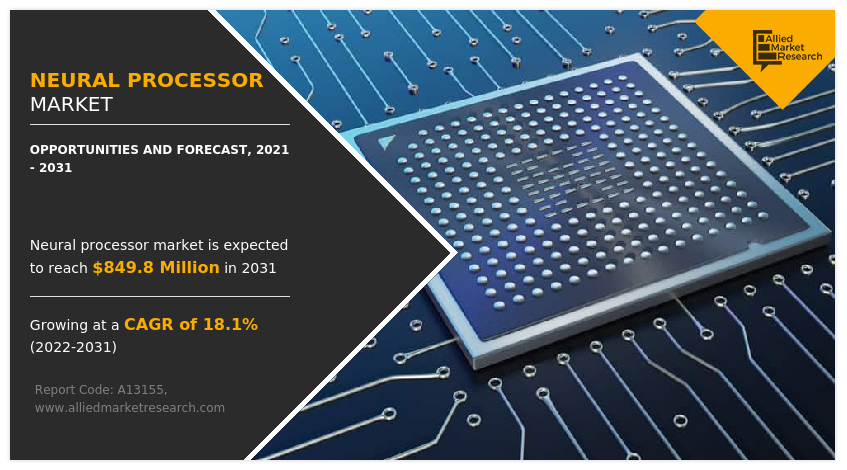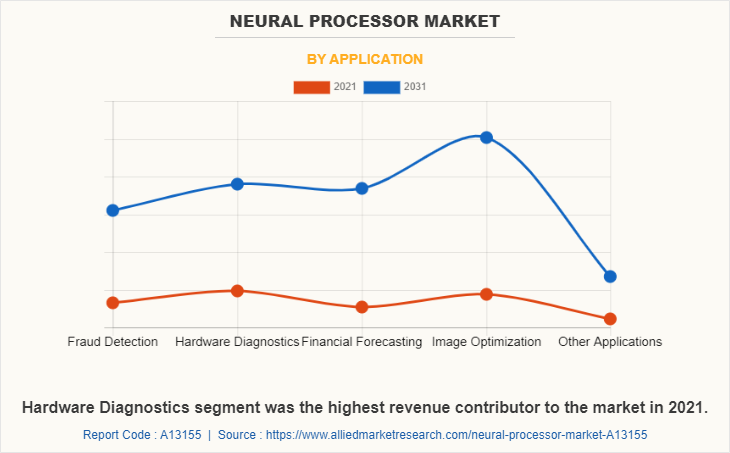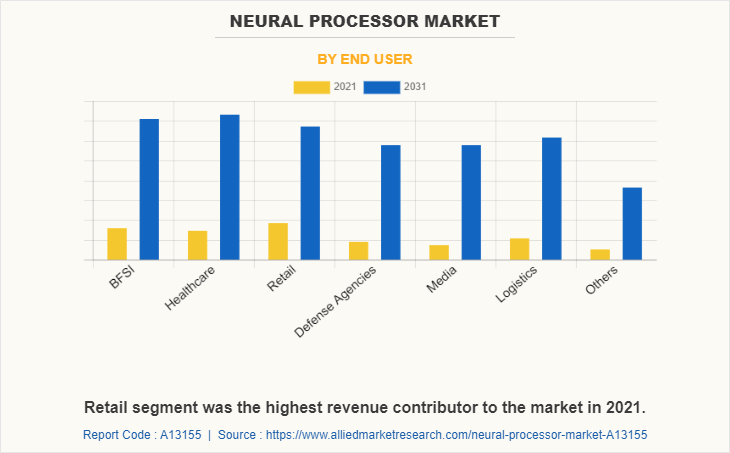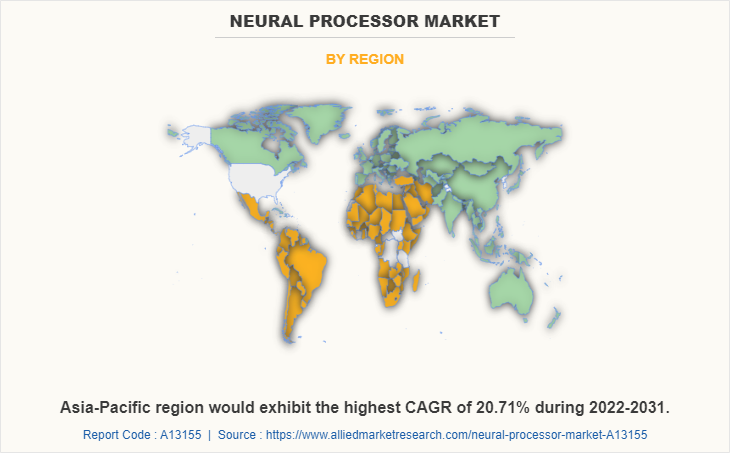Neural Processor Market Research, 2031
The global neural processor market was valued at $162.1 million in 2021, and is projected to reach $849.8 million by 2031, growing at a CAGR of 18.1% from 2022 to 2031.
A neural processor, also known as a neural processing unit (NPU), is a specialized circuit that implements all of the control and arithmetic logic required to run machine learning algorithms, often by working on predictive models like artificial neural networks (ANNs) or random forests (RFs). Neural processor can be built digitally or analogically. Analog chips more closely resemble the biological qualities of neural networks than digital processors. For replicating the differential equations of neurons in analogue architecture, only a few transistors are used. As a result, they should use less energy than digital neuromorphic processors in theory. Furthermore, they have the ability to extend the processing period beyond the time allotted. This feature allows the pace to be increased to process data quicker than in real-time. However, due to the analog architecture, there is more noise, which reduces precision. All these factors are assisting the growth of the neural processor market share globally.

The neural processor market is segmented into Application and End User.

By application, the market is divided into fraud detection, hardware diagnostics, financial forecasting, image optimization, and other applications. The hardware diagnostics segment was the highest revenue contributor to the market in 2021.

As per end user, it is segmented into BFSI, healthcare, retail, defense agencies, media, logistics, and others. The retail segment was the highest revenue contributor to the market in 2021.

Region wise, the neural processor market trends are analyzed across North America (the U.S. and Canada), Europe (France, Germany, Italy, Spain UK, and rest of Europe), Asia-Pacific (China, Japan, India, South Korea, Australia, and rest of Asia-Pacific), and LAMEA (Latin America, the Middle East, and Africa).
The increasing adoption of the machine learning approach in various sectors such as BFSI, healthcare, retail, and others along with rapid transition in the information industry are a few of the critical factors responsible for the growth of the neural processor market. The neural net processor is extensively used for developing an operational effective predictive model and maximize resource utilization.
They have been introduced in the fields of computer vision, robot kinetics, pattern recognition, speech recognition, data analytics, data compression, and many more. The increasing use of data in the various fields is boosting the growth of the neural processor market.
Significant factors that impact growth of the neural processor industry include surge in applications of neural processors in automotive industry. Moreover, rapid adoption of AI to improve consumer services and reduce operational cost is expected to drive the neural processor market growth. However, lack of skilled AI workforce acts as a prime barrier for early adoption, which hampers growth of the neural processor market share. On the contrary, introduction of AI to edge devices offers potential growth opportunities for the neural processor market size.
Competitive analysis and profiles of the major neural processor industry players, such as Applied Brain Research Inc., Aspinity, Inc., Bitbrain Technologies, BrainCo, Inc., BrainChip Inc., General Vision, Inc., Halo Neuroscience, HRL Laboratories, LLC, Hewlett Packard Enterprise Development LP, and Samsung Electronics are provided in this report.
Key Benefits For Stakeholders
- This report provides a quantitative analysis of the market segments, current trends, estimations, and dynamics of the neural processor market analysis from 2021 to 2031 to identify the prevailing neural processor market opportunity.
- The market research is offered along with information related to key drivers, restraints, and opportunities.
- Porter's five forces analysis highlights the potency of buyers and suppliers to enable stakeholders make profit-oriented business decisions and strengthen their supplier-buyer network.
- In-depth analysis of the neural processor market overview assists to determine the prevailing market opportunities.
- Major countries in each region are mapped according to their revenue contribution to the global market.
- Market player positioning facilitates benchmarking and provides a clear understanding of the present position of the market players.
- The report includes the analysis of the regional as well as global neural processor market trends, key players, market segments, application areas, neural processor market forecast and market growth strategies.
Neural Processor Market Report Highlights
| Aspects | Details |
| Market Size By 2031 | USD 849.8 million |
| Growth Rate | CAGR of 18.1% |
| Forecast period | 2021 - 2031 |
| Report Pages | 207 |
| By Application |
|
| By End User |
|
| By Region |
|
| Key Market Players | BrainCo, Inc., General Vision, Inc., Halo Neuroscience, Applied Brain Research, Bitbrain Technologies, BrainChip, Inc., Aspinity, Inc., Hewlett Packard Enterprise Development LP, Samsung Electronics Co. Ltd., HRL Laboratories, LLC |
Analyst Review
The neural processors are extensively used for automation processes and for real-time processes in various industries. The neural processing units are utilized to implement machine learning techniques like random forests and artificial neural networks, allowing for an adaptable machine learning approach to varied functions. The neural network processors decrease the use of computer processing from the entire network of computers. They have a number of advantages, including the ability to accelerate computations, maximize resource utilization, and automate processes. In the electronics, retail, automotive, and manufacturing industries, they are frequently used.
They help in real-time operations which are applicable in various retail operations. The application of neural processing units in automation, speech recognition, and robot kinetics helps in innovations in various sectors such as retail, banking, and entertainment sectors. They help in developing automated processes, functions for self-driving in automotive, and artificial intelligence in electronic sectors. The growth of BFSI, e-commerce, and healthcare are increasing the demand for neural processors.
The key players profiled in the report include neural processor market players, such as Applied Brain Research Inc., Aspinity, Inc., Bitbrain Technologies, BrainCo, Inc., BrainChip Inc., General Vision Inc., Halo Neuroscience, HRL Laboratories, LLC., Hewlett Packard Enterprise Development LP, and Samsung Electronics.
The Neural Processor Market is expected to grow at a CAGR of 18.11% from 2022-2031.
The leading applications of Neural Processor are fraud detection, hardware diagnostics, financial forecasting, image optimization, and other
North America was the largest regional market for Neural Processor in 2021.
The global neural processor market was valued at $162.1 million in 2021.
Applied Brain Research Inc., Aspinity, Inc., Bitbrain Technologies, BrainCo, Inc. are the top companies to hold the market share in the Neural Processor Market.
Loading Table Of Content...



